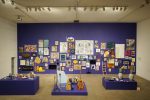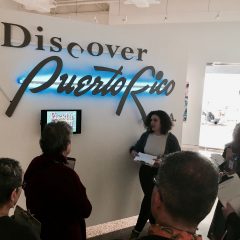The three top prizes at this year’s Victory for Tyler exhibit (subtitled Sculpture 2009), went to Philadelphia artists.
The huge, 29-artist exhibit attracted 500 people to Saturday’s opening at the Ice Box at the Crane Arts Center. There is a second opening tonight, at The Crane’s Second Thursday, 6-9 p.m. that will include some more performances. So it would be a good time to go if you missed the opening, since performance was a key part of so many of the pieces.
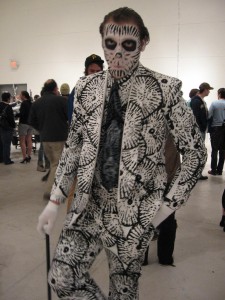
Juried by Sarina Basta, a curator at SculptureCenter in Long Island City, N.Y., the show is exuberant and full of unexpected takes on what it means to be human and what it means to be categorized as sculpture, with a sharp emphasis on art about the body and fashion. It’s an exhibit that would be comfortable anywhere in the contemporary art world.
Basta also chose the prize winners:
- First prize $1,500 Josh Kerner, Chris Golas and Joseph DiGuiseppi for their piece “The Plebeians.”
- 2nd Prize $1,000 Susanne Gieske for You Can’t Help Yourself
- 3rd prize $500 Tim Belknap, The Future is now a Shade of Grey
The money comes from a grant from Temple University’s Alumni Association.
Taking first and second prize were artists associated with FLUXspace—
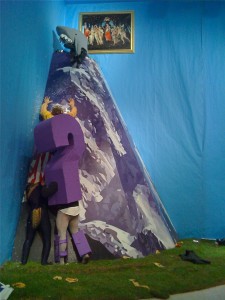
“The Plebeians,” which won prize numero uno, casts its creators DiGiuseppe, Kerner and Golas as three of four actors in an art fairy tale–an attempt to climb an 18-foot mountain installation set in front of a sky blue corner of the room. A shark guards the top of the mountain, a Botticelli reproduction hanging in the sky behind him–the mythical ogre guarding the treasure. He cooks and heaves waffles down and blows “snow” confetti down at Prince Charming, his Trusty Steed, and Sir Question Mark who are trying to climb art’s heady heights to steal the treasure. The piece has a loveable storybook and DIY affect, and is of course in part about the artists’ personal ambitions, but it invites broader readings. The go-for-broke scale plus the energy and charm of the Perils of Pauline performance make this piece a big surprise as well as a good-natured challenge to the institutions of the past.
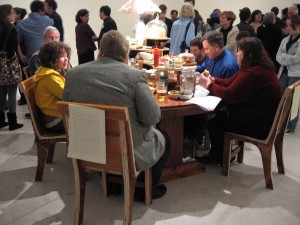
Numero dos went to FLUX’s program coordinator, Susanna Gieske, for her dining-in-the-gallery piece, You Can’t Help Yourself. This performance piece–an enormous table and chairs set in the center of the enormous Ice Box space, decked out with settings and a full meal–also dominated the room. This amazing reimagining of the role of the gallery space also challenges the family. The title is an ambiguous accusation or perhaps an ambiguous anti-invitation. The invitations were hand-written letters, a mix of passive-aggressive expressions of disappointment and love.
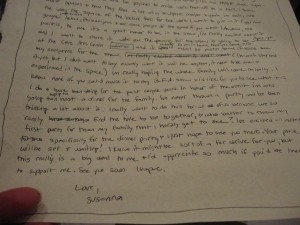
The family was a little shocked that the gallery was where they would be eating, but once they got the picture, they gamely dug in!!! The individualized invitations hung on the back of each diner’s chair. This turning of the tables so that the audience becomes the performer, the personal becomes the public, is pretty amazing.
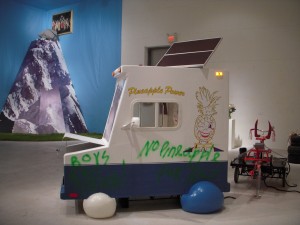
Prize number 3 went to Belknap for his installation, The Future is Now a Shade of Grey. Belknap’s piece recycles his Fleisher Challenge exhibit last year bringing the narrative story of that installation forward. Mr. Pineapple’s now-grafitti-scrawled truck has seen some battles. It’s propped up on yoga balls and pulling (if it could pull) a small flatbed holding a severed hand. When asked early in the evening about his options to win a prize, the artist (who also has ties to FLUXspace, having curated shows there) quipped that if we saw him later passed out from too much beer that meant he’d won, because the prizes were probably beer tickets!
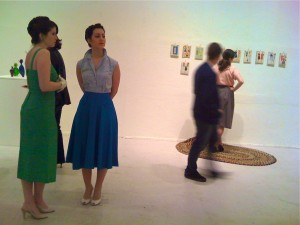
The overwhelming focus of the show was bodies in motion, bodies in clothes, and bodies as symbols for survival. We saw Laura Hricko‘s models floating around the room in “antique” hand-made garments based on “antique”–ahem 1950s–sewing patterns posted on the wall. The body as shaped by clothes was a reminder of how fashion reflects the values of a culture.
Just for the record, we learned the juror didn’t know that Hricko was related to Ice Box co-founder Richard Hricko.
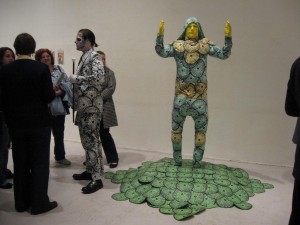
Gregory Labold arrived in costume– his own handmade suit and matching black-and-white stripes makeup–a blood borther to his sculpture “Mr. Green is Very Mean in This Scene.” Mr Green, or Moldman, is half Joker, half Ferengi. Labold stole the show from his own golem. And his little coloring zine, which we were happy to accept, invited readers to draw their own mold in the pictured petri dish. We laughed out loud.
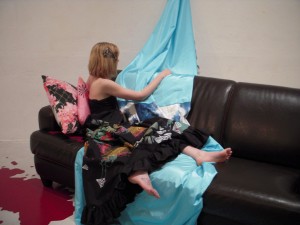
Also wearing a home grown outfit was the young model in Candy Depew’s installation “Ode,” a very fashionable work, with a clothed odalisque nodding to Manet, Ingres and all other art historical ladies on couches surrounded by pillows and drapery. The faux blood on the floor beside the couch is an oddly satisfying touch, reminding of how gansters have molls who often are fashionistas!
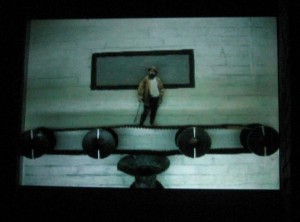
Elsewhere, saving us from Labold’s Moldman and his killer mold is Ianthe Jackson’s terrific Purifyer, a stop action animation of people on an assembly-line conveyer belt undergoing some kind of irradiation or germ detection process. The conveyer belt looks like a bicycle chain kind of gizmo–all DIY herky-jerky–so when one of the people gets vaporized (not pure enough we suppose), it comes as a shock. Simple in concept and broad enough to apply in all kinds of ways, it’s political and it’s a throwback to early special effects in early sci-fi movies. The timing of the action as well as the style is serio-comic and retro. (There’s a nice old-fashioned clanging bell that signals the entrance of another human taking a ride on the belt.)
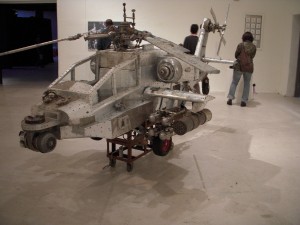
Gene Hracho’s endearingly-low tech helicopter, sited around the corner from Jackson’s conveyer belt video, is a great oversized toy that came together in a garage over the last three years, said Hracho’s parents who hovered proudly near their son’s creation (he was expected but not there yet when we talked with them).
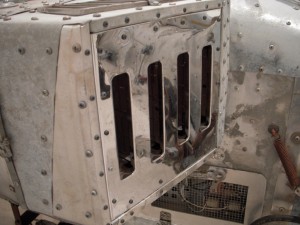
Aluminum jello molds, tin cans, cranks from egg beaters and, the piece de resistance, two, four-slice toasters, try to bridge the gap between kitchen and aerospace-engineering. The labor of love is not for sale but Hracho pere has been encouraging his son to get in touch with helicopter manufacturers who might just like to display his ur-machine in their lobbies.
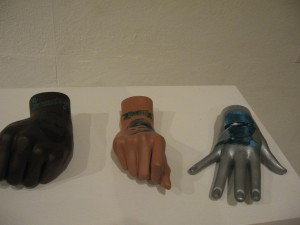
In another take on body and fashion, Francine Gintoff’s hands sport tattoo-like portraits of an unlikely trio–Cassius Clay, Ayn Rand, and Gort (the robot from the film When the Earth Stood Still). We wondered if Gintoff was a student of Susan Moore, whose paintings of tattooed people (real tattoos on real people) are showing at LaSalle College right now. Gintoff’s off-putting hands seem to be about skin and skin color and the future of humankind–we’ve got a dark brown hand for Cassius (aka Cassius Clay aka Muhammed Ali), a tan hand for Ayn, and a silver hand for Gort. All three subjects, not to mention tattoos, can be interpreted as threats by some, but the hands are not in threatening poses.
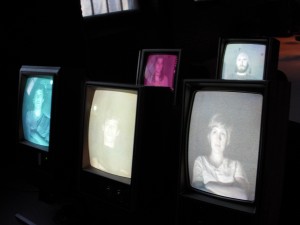
Faces and extreme attitudinalality are Sarah O’Donnell’s m-o in her untitled video installation with televisions “seated” on theatre chairs, each one showing an arms-crossed young person staring blankly ahead. A movie theatre audience is suggested but the blank stares and crossed arms also call to mind a room of high schoolers being lectured or individual teenagers receiving some bad news from mom. Like Andy Warhol’s screen tests, these static vignettes focused on faces are slow-cooked and pretty great.
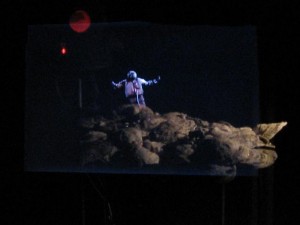
And speaking of sci-fi and clothes making the woman, Roxana Perez-Mendez’s New Espacio, a video of herself as the first Puerto Rican space walker, seemed to reach a wonderful new level of visual immateriality and unmoored floatiness in its presentation. The floaty version reflected off a visible video screen–which explained how she created the more immaterial version and somehow doubled the pleasure.
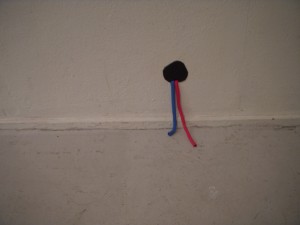
Finally, Austin Lee’s minimalist Impulse Artwork, red and blue “worms” snaking through holes in the Icebox and Grey Area walls, should win the wallflower prize. If you didn’t look closely you’d miss this piece sited far below eyelevel and dangling, modestly suggestive. The piece’s charms lie in its subtle evocation of nature (worms), candy (licorice twists), people (girl and boy) and technology (that mass of electrical cords and cables that are lifelines to grids of electricity, fiber optics and other miracles of contemporary plugged-in-ness.)
The show is up to April 26, 2009.


